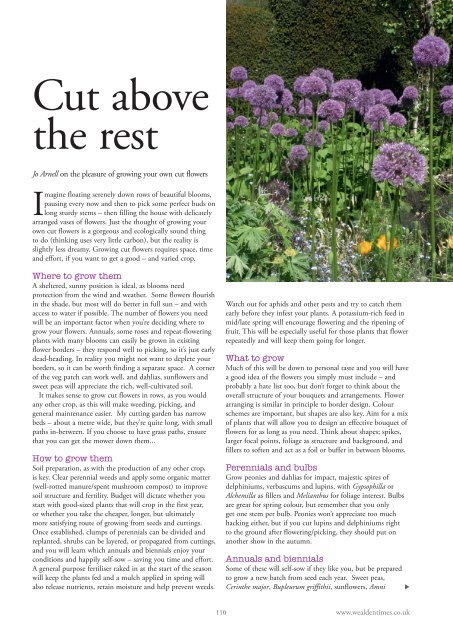Surrey Homes | SH21 | July 2016 | Interiors supplement inside
The lifestyle magazine for Surrey - Interiors Supplement, Fabulous Fashion, Delicious Dishes
The lifestyle magazine for Surrey - Interiors Supplement, Fabulous Fashion, Delicious Dishes
You also want an ePaper? Increase the reach of your titles
YUMPU automatically turns print PDFs into web optimized ePapers that Google loves.
Cut above<br />
the rest<br />
Jo Arnell on the pleasure of growing your own cut flowers<br />
Imagine floating serenely down rows of beautiful blooms,<br />
pausing every now and then to pick some perfect buds on<br />
long sturdy stems – then filling the house with delicately<br />
arranged vases of flowers. Just the thought of growing your<br />
own cut flowers is a gorgeous and ecologically sound thing<br />
to do (thinking uses very little carbon), but the reality is<br />
slightly less dreamy. Growing cut flowers requires space, time<br />
and effort, if you want to get a good – and varied crop.<br />
Where to grow them<br />
A sheltered, sunny position is ideal, as blooms need<br />
protection from the wind and weather. Some flowers flourish<br />
in the shade, but most will do better in full sun – and with<br />
access to water if possible. The number of flowers you need<br />
will be an important factor when you’re deciding where to<br />
grow your flowers. Annuals, some roses and repeat-flowering<br />
plants with many blooms can easily be grown in existing<br />
flower borders – they respond well to picking, so it’s just early<br />
dead-heading. In reality you might not want to deplete your<br />
borders, so it can be worth finding a separate space. A corner<br />
of the veg patch can work well, and dahlias, sunflowers and<br />
sweet peas will appreciate the rich, well-cultivated soil.<br />
It makes sense to grow cut flowers in rows, as you would<br />
any other crop, as this will make weeding, picking, and<br />
general maintenance easier. My cutting garden has narrow<br />
beds – about a metre wide, but they’re quite long, with small<br />
paths in-between. If you choose to have grass paths, ensure<br />
that you can get the mower down them...<br />
How to grow them<br />
Soil preparation, as with the production of any other crop,<br />
is key. Clear perennial weeds and apply some organic matter<br />
(well-rotted manure/spent mushroom compost) to improve<br />
soil structure and fertility. Budget will dictate whether you<br />
start with good-sized plants that will crop in the first year,<br />
or whether you take the cheaper, longer, but ultimately<br />
more satisfying route of growing from seeds and cuttings.<br />
Once established, clumps of perennials can be divided and<br />
replanted, shrubs can be layered, or propagated from cuttings,<br />
and you will learn which annuals and biennials enjoy your<br />
conditions and happily self-sow – saving you time and effort.<br />
A general purpose fertiliser raked in at the start of the season<br />
will keep the plants fed and a mulch applied in spring will<br />
also release nutrients, retain moisture and help prevent weeds.<br />
Watch out for aphids and other pests and try to catch them<br />
early before they infest your plants. A potassium-rich feed in<br />
mid/late spring will encourage flowering and the ripening of<br />
fruit. This will be especially useful for those plants that flower<br />
repeatedly and will keep them going for longer.<br />
What to grow<br />
Much of this will be down to personal taste and you will have<br />
a good idea of the flowers you simply must include – and<br />
probably a hate list too, but don’t forget to think about the<br />
overall structure of your bouquets and arrangements. Flower<br />
arranging is similar in principle to border design. Colour<br />
schemes are important, but shapes are also key. Aim for a mix<br />
of plants that will allow you to design an effective bouquet of<br />
flowers for as long as you need. Think about shapes; spikes,<br />
larger focal points, foliage as structure and background, and<br />
fillers to soften and act as a foil or buffer in between blooms.<br />
Perennials and bulbs<br />
Grow peonies and dahlias for impact, majestic spires of<br />
delphiniums, verbascums and lupins, with Gypsophilla or<br />
Alchemilla as fillers and Melianthus for foliage interest. Bulbs<br />
are great for spring colour, but remember that you only<br />
get one stem per bulb. Peonies won’t appreciate too much<br />
hacking either, but if you cut lupins and delphiniums right<br />
to the ground after flowering/picking, they should put on<br />
another show in the autumn.<br />
Annuals and biennials<br />
Some of these will self-sow if they like you, but be prepared<br />
to grow a new batch from seed each year. Sweet peas,<br />
Cerinthe major, Bupleurum griffithii, sunflowers, Amni <br />
110 www.wealdentimes.co.uk


















